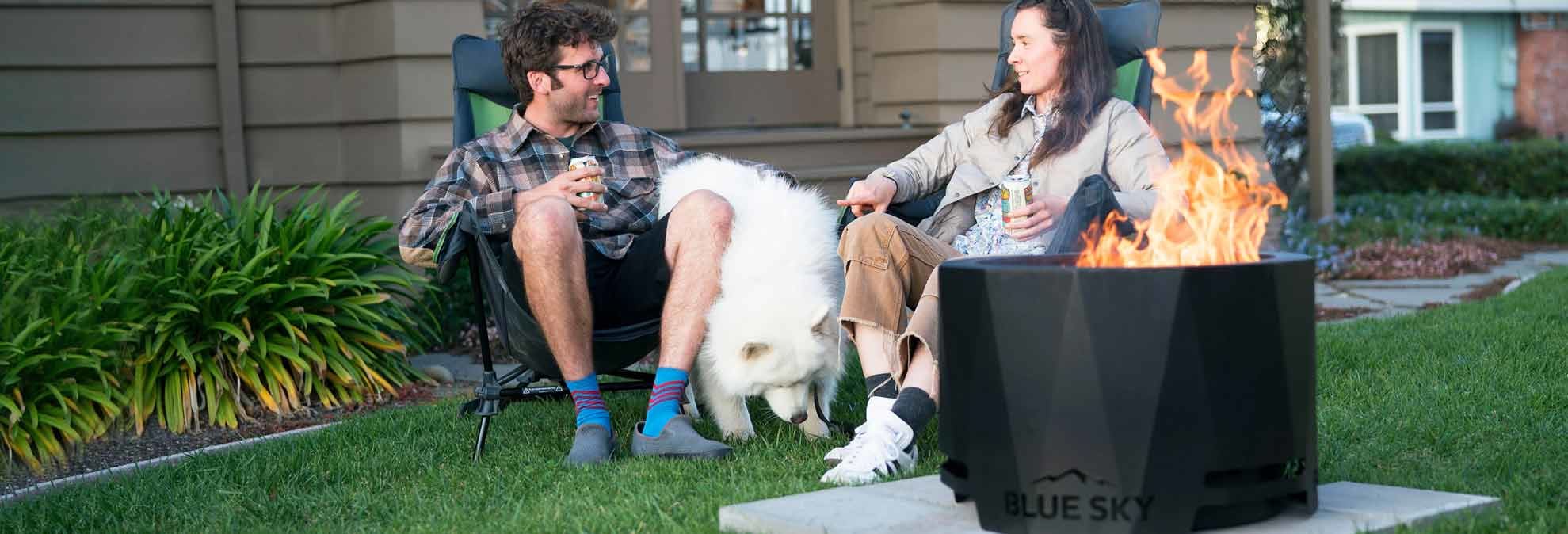
Smokeless Firepit Buying Guide

Home & DIY Editor
There’s nothing like cozying up to a roaring wood fire on a cool evening. Less fun is doing the obligatory load of laundry to rid your clothes of the smoky smell. Enter smokeless firepits. These engineering marvels have been widely available for about a decade, but their popularity has skyrocketed since the pandemic. Consumer Reports recently put seven popular smokeless firepits through rigorous tests and found that performance can vary widely. In this guide, we explain how to separate the best from the worst. CR members can also read about the best models of the year or jump right to our smokeless firepit ratings.
How Does a Smokeless Firepit Work?
All wood fires produce some level of smoke, but a hotter fire produces less. Smokeless firepits are built to promote exceptionally thorough combustion, resulting in a fire that’s hotter, and in turn, less smoky.
Most smokeless firepits have both an inner and outer wall, along with holes or vents in each to promote airflow. Sandwiching a layer of hot air between the two walls helps promote hotter burning. So does the targeted airflow created by holes or vents. The result? A fire that burns optimally and with less smoke than an open fire.
Traditional vs. Smokeless Firepits
The process for building a wood fire with a smokeless firepit is the same as with a traditional firepit. And yet the two types are designed quite differently.
Traditional freestanding firepits can vary in shape, from spherical or round to square or rectangular. But most are formed from a single layer of stamped metal, like coated steel, and are little more than a stand to contain a fire and elevate it above the ground. The airflow and the direction of the flames are largely dictated by the wind. Some traditional firepits are also built into the ground or formed from pavers or stones. They have a built-in appearance but offer the same functionality as a freestanding firepit.
A smokeless firepit is typically made from two layers of metal, often stainless steel or coated steel. Most models are cylindrical and have sides that shield the fire from wind. Instead, the holes in the side and bottom of a smokeless firepit help direct air to feed the fire without causing it to blow out of control. Because of this added layer of metal, they tend to be more expensive than conventional firepits, but most are no harder to assemble or use.
How to Choose a Smokeless Firepit
Finding the right smokeless firepit depends on how you want to use it and who you’re using it with. Here’s what to keep in mind as you shop.
Size. Determine the right size by considering how many people will be using it and how big a space you intend to use it in. There’s no hard-and-fast rule for how many people can fit around firepits of a certain size, but obviously, larger models will provide warmth for a bigger crowd. The smokeless firepits we’ve evaluated range from about 13 to 19 inches tall and 16 to 25 inches in diameter. Many manufacturers, including Solo Stove and Breeo, offer smokeless firepits with very similar designs in different sizes.
Capacity. A large footprint doesn’t always correlate with a large capacity for firewood. Even some of the largest smokeless firepits have inserts or designs that limit your ability to build a large fire. If you want to burn large fires, look for a model that will hold at least four pieces of cut firewood at a time.
Weight. A heavy firepit can resist bending and flexing and may hold up better in the long run. But if you plan to take your smokeless firepit on excursions to the beach, a campsite, or a friend’s house, splurging on a hefty model isn’t worth it. Instead, look for a lighter model that’s easier to move. Those we’ve reviewed weigh between 14 and 46 pounds.
Dual Fuel Compatibility. A majority of smokeless firepits are built to burn wood. But some are designed to use wood pellets, a manufactured product made from sawdust and binders. A handful of smokeless firepits can burn both. Wood is more readily available because you may be able to collect it in your own yard or buy it from most gas stations. But pellets, available at home centers and well-stocked hardware stores, can be easier to store and light, particularly those that are pretreated with an accelerant to promote quick lighting. A smokeless firepit that can burn both is the most versatile, but you’ll also pay a premium. In some cases, you can buy an add-on accessory that holds pellets to retrofit a wood-burning firepit.
Cooking Accessories. Some manufacturers offer add-ons that allow you to cook directly over the fire burning in a smokeless firepit. These accessories include everything from grill grates with adjustable heights to griddles and even outdoor woks. If you want the ability to convert your smokeless firepit into an outdoor cooking appliance, look for a model with a good selection of compatible cooking accessories.
Where Can You Use a Smokeless Firepit?
You can use a smokeless firepit anywhere you’d use a conventional firepit—sufficiently far (at least 20 feet) from your house or any outdoor structure or materials. And because a smokeless firepit burns hot even with a double-wall design, it shouldn’t be used on a deck. Wood fires burn at temperatures in excess of 1,000° F, which is more than hot enough to damage a wood deck. The same holds true for composites. Trex, one of the largest manufacturers of composite decking, notes that its deck boards will soften at temperatures as low as 176° F.
Your safest bet is a hard surface (like a concrete slab or patio) in an open area with nonflammable materials above, below, or around it. A stone patio, gravel driveway, or grass field can work, but an area littered with dry pine needles or dead dried grass isn’t safe. For more tips on preventing mishaps, see our firepit safety guide.
Smokeless Firepit Brands
BioLite, a manufacturer of outdoor camping gear, offers a single wood- and charcoal-burning smokeless firepit. It’s built to work with add-on cooking accessories.
Blue Sky Outdoor Products makes multiple sizes of smokeless firepits, all of which can be outfitted with cooking accessories. Its products are sold through the brand’s own website and on Amazon.
Breeo claims to have invented the first smokeless firepit in 2011. Its products are built in the U.S. and sold directly through its website. All of its models are designed to accept add-on cooking accessories.
Cuisinart, the maker of small kitchen appliances, has expanded its outdoor offerings to include grills and smokeless firepits. At present, it makes only one model of the latter, and there are no add-on accessories for cooking.
INNO Stage makes outdoor products ranging from hammocks to smokeless firepits. Sold on Amazon, its offerings are among the least expensive.
Solo Stove is perhaps the most prominent maker of smokeless firepits, having gained popularity at the beginning of the pandemic. Its vast selection of firepits ranges from tiny tabletop models made just for s’mores to large models designed to accommodate six or more people. Solo Stove offers cooking accessories, fire starters, and several tools and accessories.
Tiki makes multiple smokeless firepits sold directly through its website as well as at major retailers like Amazon and Home Depot. It offers quite a few different sizes, but cooking accessories aren’t available.






















